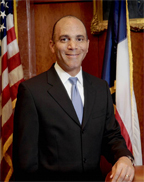© 2013 The Texas Lawbook.
By Marie Yeates and Tom Leatherbury
Contributing Writers to The Texas Lawbook
(September 23) – Wallace Jefferson, outgoing Chief Justice of the Texas Supreme Court, will retire from the Court leaving one of the greatest legacies of any public servant in Texas history.

That year, Perry appointed Jefferson to be an Associate Justice on the Texas Supreme Court. Just three years later, the Court’s then-Chief Justice, Thomas Phillips, resigned. Perry again turned to Jefferson, appointing Jefferson to be the 26th Chief Justice of Texas and the State’s first African-American Chief Justice.
In his role as the state’s top judge, Jefferson wrote some of the most influential Supreme Court decisions in a decade.
In Compaq Computer Corporation v. Lapray, 135 S.W.3d 657 (Tex. 2004), Jefferson wrote the Court’s opinion establishing standards governing the certification of class-action lawsuits throughout Texas. The decision gives significant attention to protecting putative class members’ rights to receive notice of the class action and to be given an opportunity to opt out of it.
The decision also requires that, before a Texas trial court can certify a nationwide class-action lawsuit—with numerous connections to jurisdictions other than Texas—the court must (1) determine which states’ laws will govern the class members’ claims, and (2) analyze those laws to determine whether they are similar enough that the lawsuit can proceed as a class action (i.e., that, given the various laws that must be applied, a class-action lawsuit would satisfy the requirements of predominance, superiority, cohesiveness, and manageability).
In Grant Thornton LLP v. Prospect High Income Fund, 314 S.W.3d 913 (Tex. 2010), Jefferson wrote for a unanimous Court in clarifying the situations in which Texas law permits a company’s outside auditor to be held liable for negligent misrepresentation and common-law fraud, where the auditor is sued not by the audited company (the auditor’s client), but by a third party that allegedly relied on the auditor’s report in deciding to invest in the audited company.

One of Jefferson’s most moving decisions came in the family law case In re E.R., 385 S.W.3d 552 (Tex. 2012). There, the State petitioned the trial court permanently to sever the parent–child relationship between a mother and her children. Even though the mother had attended prior court hearings and had recently visited her children (who were in the State’s care), publication notice (i.e., notice by newspaper) was the only method used to inform the mother of the suit.
The mother did not appear at the final hearing, and the trial court terminated her relationship with her children. After the mother learned of the termination proceeding, she filed a motion for new trial, and her case ultimately went to the Supreme Court. The Court held that the State’s use of publication service (by newspaper) violated the mother’s due process rights because the State did not use sufficient diligence in attempting personally to serve the mother.

Chief Justice Jefferson’s majority opinions garnered significant (and, frequently, unanimous) support among his colleagues on the bench. Of the ninety-nine majority opinions the Chief authored, a remarkable seventy-six were met with no dissenting opinion.
Jefferson’s work on the Court was not limited to writing noteworthy decisions. Under Jefferson’s watch, the Court implemented a number of initiatives to improve the justice system for the people of Texas. Through hard work and dedication, the Court greatly enhanced its efficiency, carrying very few cases over from one term to the next.
Through Jefferson’s embrace of technology, the Court increased the transparency with which it operates, installing fixed cameras in its courtroom so that the public can view oral arguments live online, and making appellate filings and decisions freely available to the public for download on the Supreme Court’s website.
Jefferson worked closely with the Texas Legislature to secure a pay raise for Texas justices, thereby assisting the State in attracting and retaining the brightest legal minds to serve as jurists in Texas.
Jefferson also demonstrated his deep passion for assisting those who are least able to afford legal representation. As Chief Justice, Jefferson worked closely with the Legislature to increase funds allocated for providing legal assistance to the poor. Jefferson vigorously supported the Texas Access to Justice Commission, an organization chaired by Harry Reasoner that leads initiatives and projects devoted to improving access to civil justice for low-income Texans.
According to Reasoner, “Chief Justice Jefferson set a national standard for state supreme courts taking a leadership role in increasing access to justice for those who cannot afford lawyers.” Reasoner praises the Court, under Chief Justice Jefferson’s watch, for creating “the Permanent Judicial Commission for Children, Youth and Families to work at improving the treatment of families and children in the courts and those taken from their families by the State.”
Reasoner explains that, “[w]ith the diminishment of funding for pro bono representation, the Supreme Court played a critical role in securing funding for to ameliorate the losses. The Supreme Court has elevated access to justice to new levels in Texas.”
As part of the effort to make the justice system more accessible, the Court under Chief Justice Jefferson approved legal forms for use by indigent Texans in straightforward family-law matters.
Apart from his work on the Supreme Court of Texas, Jefferson was heavily involved in a variety of organizations devoted to the development of the judicial system both in Texas and beyond the borders of our State. Most prominently, Jefferson served as President of the Conference of Chief Justices, an association of chief justices from all 50 states and U.S. territories.
Jefferson served (and continues to serve) on the Council of the American Law Institute (commonly known as the ALI), a group dedicated to clarifying and simplifying U.S. law through publication of the various Restatements of the Law and promulgation of model codes. Finally, Jefferson serves on the Board of the Sandra Day O’Connor Judicial Selection Initiative.
Jefferson’s exemplary service is reflected in the many accolades he has collected in his nearly thirteen years on the Court. He holds honorary degrees from Michigan State University, the University of New Hampshire School of Law, Hofstra Law School, and Pepperdine University. He is the namesake for the Wallace B. Jefferson Middle School in San Antonio. This year, Jefferson was honored with the Texas Exes’ Distinguished Alumnus Award.
As his decisions and accomplishments show, as Chief Justice, Wallace Jefferson was a leader of the bench, a servant to the people of Texas, and a supporter of the bar. After devoting twelve years of his life to exemplary service of the public, Jefferson is now ready to return to his first calling—that of serving his clients.
© 2013 The Texas Lawbook. Content of The Texas Lawbook is controlled and protected by specific licensing agreements with our subscribers and under federal copyright laws. Any distribution of this content without the consent of The Texas Lawbook is prohibited.
If you see any inaccuracy in any article in The Texas Lawbook, please contact us. Our goal is content that is 100% true and accurate. Thank you.
